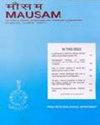苏门答腊岛地形对印度洋热带气旋形成的影响
IF 0.7
4区 地球科学
Q4 METEOROLOGY & ATMOSPHERIC SCIENCES
引用次数: 0
摘要
世界上四分之一的热带气旋(tc)发生在印度洋(IO)盆地。IO中TC的形成机制多种多样,但最近发现的一个过程涉及苏门答腊岛陡峭地形周围的流动。在典型的环境分层条件下,当低层气流撞击苏门答腊岛时,气流被阻挡并分裂。因此,尾流涡通常在岛屿的北部和南部岛屿尖端发展。在东风气流的情况下,这些环流随后在IO上向下游移动。从岛屿顶端发出的尾流涡是反向旋转的,但由于苏门答腊岛横跨赤道,两个半球的环流都是气旋式的,因此有可能发展成热带气旋。利用DYNAMO和YOTC的2.5年观测数据,发现在此期间发生在io盆地上空的大约25%的tcs是由苏门答腊诱导的尾流涡引起的。对2008- 2017年期间涡旋统计数据的进一步分析发现,涡旋数量在马登-朱利安涛动(MJO)第1阶段附近最高,此时低层东风在苏门答腊岛南部最强。当低空西风带存在于苏门答腊以西赤道附近时,在MJO第4阶段出现二次涡形成高峰。后一项发现表明,与mjo相关的赤道低空西风浪冲击苏门答腊,有助于尾流涡发展的增加。数值模拟表明,更远的上游环流,如西太平洋残余涡和婆罗洲涡可以影响苏门答腊尾流涡的发展及其在印度洋上空发展为涡。本文章由计算机程序翻译,如有差异,请以英文原文为准。
Effects of the Topography of Sumatra on Tropical Cyclone Formation over the Indian Ocean
One-quarter of the world’s tropical cyclones (TCs) occur in the Indian Ocean (IO) basin.The mechanisms for TC initiation in the IO are varied, but one recently discovered process involves the flow around the steep topography of Sumatra. When the low-level flow impinges on Sumatra, it is blocked and the flow splits under typical environmental stratification. As a result, wake vortices commonly develop at northern and southern island tips of the island. For the case of easterly flow, these circulationssubsequently move downstream over the IO. The wake vortices emanating from the island tips are counter-rotating, but since Sumatra straddles the equator, the circulations are cyclonic in both hemispheres and thus have the potential for TC development. Using data from2.5yearsof observations from DYNAMO and YOTC, it is found that approximately 25% of the TCsthat occurred overIO basin during that periodwere initiated by Sumatra-induced wake vortices.Additional analysis of vortex statistics for the period 2008-17 has found that vortex counts are highest near Madden-Julian Oscillation (MJO) phase 1 when low-level easterlies are strongest across southern Sumatra. A secondary peak in vortex formation occurs during MJO phase 4 when low-level westerlies exist near the equator west of Sumatra. The latter finding suggests that MJO-related, low-level westerly surges on the equator impinging on Sumatracontribute to an increase in wake vortex development. Numerical simulations have shown that circulations farther upstream such aswestern Pacific remnant TCs and the Borneo vortex can influence the development of Sumatra wake vortices and their growth into TCs over the IO.
求助全文
通过发布文献求助,成功后即可免费获取论文全文。
去求助
来源期刊

MAUSAM
地学-气象与大气科学
CiteScore
1.20
自引率
0.00%
发文量
1298
审稿时长
6-12 weeks
期刊介绍:
MAUSAM (Formerly Indian Journal of Meteorology, Hydrology & Geophysics), established in January 1950, is the quarterly research
journal brought out by the India Meteorological Department (IMD). MAUSAM is a medium for publication of original scientific
research work. MAUSAM is a premier scientific research journal published in this part of the world in the fields of Meteorology,
Hydrology & Geophysics. The four issues appear in January, April, July & October.
 求助内容:
求助内容: 应助结果提醒方式:
应助结果提醒方式:


